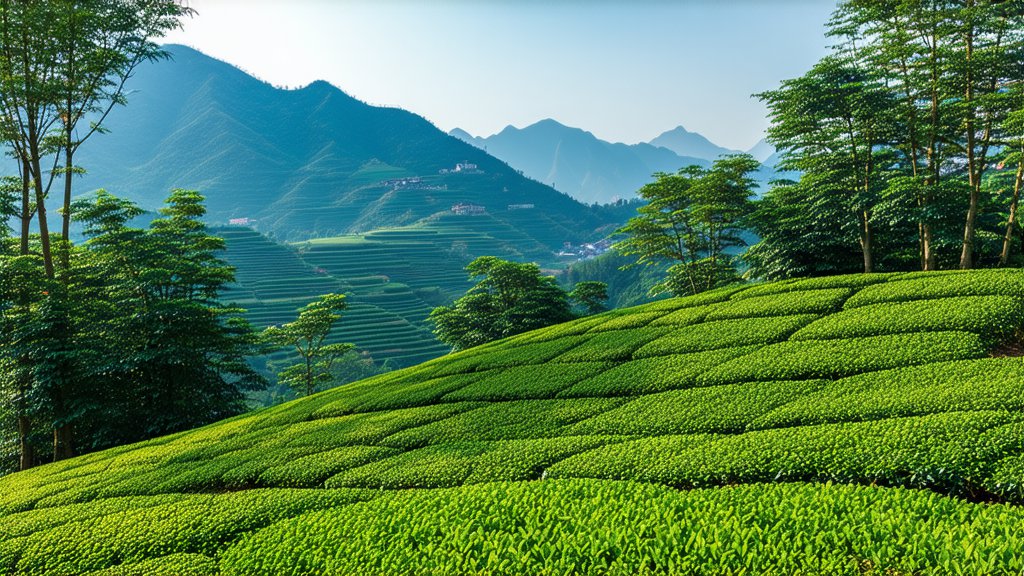
In the vast and diverse landscape of Chinese tea culture, one variety stands out for its unique flavor profile, aromatic complexity, and rich historical heritage – Tieguanyin, a premium type of oolong tea hailing from the Fujian province. This article embarks on an exploration of Tieguanyin's fascinating journey through time, its distinctive varieties, intricate production process, and the art of appreciating this exquisite beverage, all while maintaining a tone suitable for an international audience seeking to deepen their understanding of this remarkable tea.
A Glimpse into History
The name "Tieguanyin," translating to "Iron Goddess of Mercy" or "Iron Buddha," is steeped in both mythology and history. Legend has it that the tea was discovered by a poor farmer named Wei Yin during the Qing Dynasty. According to the tale, Wei Yin stumbled upon a wild tea tree while sheltering under a Bodhi tree during a thunderstorm. He collected leaves from the tree, dried them in his bamboo hat, and brewed them at home. The resulting tea was so exceptionally fragrant and flavorful that he believed it must have been blessed by the Iron Goddess of Mercy, leading to its namesake.
Anxi County, nestled within Fujian Province's mountainous terrain, became the birthplace and heartland of Tieguanyin cultivation. Over centuries, this region's unique climate, with its cool temperatures, high humidity, and fertile soil, combined with meticulous traditional farming practices, nurtured the development of Tieguanyin into the revered tea it is today.
Varieties of Tieguanyin
Tieguanyin isn't just a single tea but rather a category encompassing several sub-varieties, each with its own distinct characteristics. Among these, two primary types dominate: Xiang Xing (Fragrant Type) and Yan Xing (Steeped Type).
-
Xiang Xing (Fragrant Type): True to its name, this variety emphasizes floral and fruity aromas, often reminiscent of orchids, osmanthus, or even honey. It's known for its lighter color, more delicate taste, and higher elevation growth, which contributes to its fresher and more vibrant profile.
-
Yan Xing (Steeped Type): Also referred to as "Charcoal Roasted" or "Traditional," Yan Xing undergoes additional roasting processes after initial processing, giving it a deeper, more earthy flavor profile with hints of caramel, nuts, or even chocolate. Its leaves are darker, and the tea tends to have a fuller body and longer-lasting aftertaste.
Both varieties share the same fundamental processing steps but diverge in their final stages, creating a spectrum of flavors and experiences for tea enthusiasts to explore.
The Art of Crafting Tieguanyin
The creation of Tieguanyin is an art form that marries tradition with precision. Here's an overview of the meticulous process:
-
Plucking: Only the tender young shoots and leaves are handpicked, typically between April and October, ensuring optimal freshness and quality.
-
Withering: Fresh leaves are spread thinly on bamboo trays and left in the sun or under shade to wilt slightly, reducing moisture content and softening the cell walls for easier rolling.
-
Bruising: Leaves are gently tossed or rolled to release enzymes and initiate oxidation, crucial for developing Tieguanyin's signature flavors and aromas.
-
Fixation: Heat is applied through either pan-frying or steaming to halt enzymatic activity, preserving the desired level of oxidation and setting the foundation for the tea's character.
-
Shaking & Turning: Leaves are repeatedly shaken and turned in bamboo baskets to further bruise the edges, enhancing oxidation and shaping the leaves into their characteristic twisted form.
-
Roasting (Yan Xing only): For the Yan Xing variety, additional roasting over charcoal fires imparts a smoky depth and complexity, distinguishing it from its Fragrant counterpart.
-
Sifting & Sorting: Once dried, the tea is sieved to remove any imperfections and sorted by grade based on size and quality.
-
Final Touches: The finished product is carefully packaged and stored in airtight containers to preserve its freshness until it reaches the cup of an eager drinker.
Savoring the Symphony: Tasting Tieguanyin
Appreciating Tieguanyin goes beyond mere consumption; it's an experience that engages all senses. Here's how to fully immerse yourself in a Gongfu tea ceremony, the traditional Chinese method of enjoying fine teas like Tieguanyin:
-
Preparation: Use a Yixing clay teapot or a Gaiwan (a lidded bowl), along with small cups for each participant. Rinse the utensils with hot water to warm them up.
-
Measurement: Place approximately 5-7 grams of loose leaf Tieguanyin into the pot or Gaiwan, depending on personal preference and the number of servings desired.
-
Infusion: Pour hot water (around 90-95°C) over the leaves, quickly rinsing and discarding this first wash to 'wake up' the tea. Follow with a second pour, allowing the leaves to steep for about 15-30 seconds initially. Subsequent infusions can be progressively longer as the leaves open up.
-
Aroma: Before taking your first sip, inhale deeply to appreciate the tea's evolving fragrance. Note any floral, fruity, roasted, or mineral notes that emerge.
-
Tasting: Sip slowly, allowing the liquid to coat your palate. Pay attention to the balance between sweetness, bitterness, astringency, and umami, as well as the tea's mouthfeel and lingering aftertaste.
-
Observation: Examine the wet leaves post-infusion. High-quality Tieguanyin will reveal a vibrant green hue with a glossy sheen and intact leaf structure, indicative of good craftsmanship.
-
Repetition: Tieguanyin is renowned for its ability to endure multiple infusions, each revealing new layers of flavor. Continue the process, adjusting steeping times as needed, until the tea's essence fades.
In conclusion, Tieguanyin is not just a tea; it's a testament to centuries of cultural heritage, a celebration of nature's bounty, and an invitation to slow down and savor life's simple pleasures. Whether you're drawn to the ethereal scent of Xiang Xing or the robust depth of Yan Xing, there's a Tieguanyin waiting to enchant your senses and transport you to the misty mountains of Anxi, where every sip tells a story.